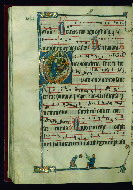Home > Digitized Walters Manuscripts
This document is a tranformation of a TEI P5 XML manuscript description incorporating images. If you have trouble reading special or non-Latin characters on this page, please make sure you have appropriate Unicode fonts installed and an up-to-date web browser.
Walters Ms. W.759, Beaupre Antiphonary, Vol. 1
Browse images (Browse images in a new window) | TEI in XML format
W.759
Beaupre Antiphonary, Vol. 1
Illuminated in Hainaut ca. 1280 and completed in 1290, this collection of richly illuminated Cistercian manuscripts is a rare example of those being produced in Flanders at the end of the thirteenth century. Eighteen extant large historiated initials, flourished and decorated initials, and an abundance of amusing drolleries facilitate a liturgical narrative within the text. However, additions and removals within the text and imagery tells much about the use and history of the manuscript. The liturgical contents of this volume provide musical settings from Easter to the Assumption of the Virgin. This manuscript is the first of a set of three volumes destined for use on the abbess’ side of the choir at the Cistercian abbey of Sainte-Marie at Beaupré (diocese of Cambrai). Two sets of antiphonaries, each composed of three volumes, were originally created for the abbess and prioress of Beaupre. Of these two sets, the Walters Art Museum houses three volumes: two volumes from the set intended for the abbess and one volume from the set designated for the prioress. A fourth associated volume was created later to supplement W.759. It should be noted that apart from the volumes housed at the Walters, there survive four cutout initials from the other volumes. However, in 1865, these manuscripts were regrettably lost in a fire that spread from a house adjacent to Sotheby’s, where the books were being prepared for sale. In addition to the manuscripts' rich illumination, there is also a wealth of historical evidence throughout. Added at the beginning of each volume is a full-page inscription that details ownership: “Antiphonaire pour sevir dans le Coeur du coté de Ma-Dame L’abbesse, à Pâques jusque â L’Assumption de Notre Dame,” as well as an anathema for a thief, and a blessing for the faithful and honest user. Further information on provenance can be gleaned from the illumination itself; the third volume (W.761) contains an author portrait of the scribe/artist, a Cistercian monk named Johannes de Toussens (fol. 1r), while the manuscripts' patroness who married into the de Viane family is depicted with a younger woman named Clementia on fol. 3v of vol. 1 (W.759). Donations by members of the de Viane family to Sainte-Marie of Beaupré were recorded from 1244 to 1293. Since the volume’s assemblage, there have been updates in two major campaigns: ca. 1475-1500 at which time select thirteenth-century Offices were replaced in part by revisions and by additions placed at the end of the volume (see W.762 for supplement) and the second campaign in the eighteenth century at which time some thirteenth- and fifteenth-century leaves were removed, changes were made to both neumes and text passim, and additions were added at the end of the volume or in the Supplement. The first of these campaigns was presumably for abbess Jacqueline Hendricx (1473-1500), the second in the eighteenth century likely for the last abbess, Angéline de Lossy (1755-96), after which point the abbey was seized during the French Revolution. Drolleries are most often found on pages with historiated initials, and principally focused on centered bas-de-page scenes. While many drolleries were effaced, some traces of these images can be recognized by their shadowy outlines. Many of these erasures are thought to be at the hand of John Ruskin, who is also credited with authoring a separate table of contents, as well as several transcriptions of the Latin text found on numerous leaves. Truly a remarkable work, this multi-volume antiphonary was generously gifted to the Walters Art Museum in 1957 at the bequest of the Hearst Foundation.
Dated 1290 CE
Hainaut
Book
Liturgical
The primary language in this manuscript is Latin. The secondary languages of this manuscript are Latin, French.
Parchment
Parchment of medium to heavy weight, well selected and prepared; extensive use evident from revisions dating from the fifteenth through eighteenth centuries, as well from cockling, stains, and grime; endleaves of thick modern parchment were added by rebinder after 1904
Foliation: iii+223+iii
Page height and width ranges from 47.5cm-48cm x 33.5cm-34cm; modern pencil foliation upper right corners rectos (used here); three other foliatiions, the first in the style of fifteenth or nineteenth-century roman numerals at or near center of fore-edge on each recto, brown ink, often erased, beginning on fol. 2, actual total of 278 folios due to repetition of numerals on fols. 148, 149, 199; second and third foliations, mostly erased in arabic numerals at outer top corner of rectos and versos, brown ink, earlier arabic foliation mostly erased, placed slightly higher than later arabic pagination, the latter being fully extant, approximately aligned with top ruling, begins on fol. 2, skipping "177" (now fol. 90r), "416" accidentally written "461" (now fol. 209r)
Formula: Quires 1-11: 8 (fols. 1-88); Quire 12: 10 (fols. 89-98); Quire 13: 8 (fols. 99-106); Quire 14: 8, with second folio cancelled (fols. 107-113); Quire 15: 8, with last folio cancelled (fols. 114-120); Quire 16: 8 (fols. 121-128); Quire 17*: 4, composite of two original and two added leaves; first and second folios are singletons, third* and fourth* folios attached after fol. 128, sewing between second and third folios (fols. 129-132); Quire 18*: 8 (fols. 133-140); Quire 19: 4 (fols. 141-144); Quires 20-21: 8 (fols. 145-160); Quire 22*: 8 (fols. 161-168); Quire 23: 2, bifolium (fols. 169-170); Quires 24-29: 8 (fols. 171-218); Quire 30: 6, with sixth folio cancelled (fols. 219-223)
Catchwords: Often extant in original text, found at lower right on last verso of quire, some cropped, in text hand; concerning later additions: extant on fols. 132v* and 140v*, only the former matches text on next recto, these read "et filio"
Signatures: Some extant at extreme lower right of rectos, finely drawn in red ink; for good examples see fols. 81r, 82r, 203r, 204r, 205r, and 206r
Comments: Later additions marked * in collation formula
33.5 cm wide by 47.5 cm high
22.5 cm wide by 35.0 cm high
- Columns: 1
- Ruled lines: 8
- Eight staves of four lines alternating with eight text lines
- Title: Beaupré Antiphonary, Vol. 1
- Hand note: Written in textura prescissa; fifteenth-century additions written in textura formata; square musical notation on four-line stave
- Decoration note: Eighteen extant historiated initials (varying in height from 2 staves and 2 lines of text to 5 staves and 5 lines of text); gold decorated initials at sixteen text-openings (1 stave and 1 line of text): two in ownership inscription (fol. 1v), antiphon in Office of Holy Saturday (fol. 2v), six in Easter Sunday Office responsories (fols. 5r, 6r, 7v, 8v, 9r-v), two in Office for Easter Monday antiphons (fols. 10v and 12r), one in vigils of Ascension (fol. 31v), two in Office of Pentecost antiphons (fols. 44r, 52v), one in Office of Trinity Sunday antiphon (fol. 58r), one in fragmentary Office of octave of Nativity of St. John Baptist antiphon (fol. 141r, Matins Magnificat); twelve flourished initials: some large (2 staves and 2 lines of text) featuring geometric or foliate motif, occasional fluer-dis-lis, colored in red and blue, emphasizing the openings in the Offices of Easter, Easter Octave, Pentecost octave, second Sunday after Pentecost (Benedictus antiphon), St. Mark, Commemoration of St. Peter, and in Common of Saints for apostles, one martyr (also Vespers antiphon), several martyrs, one confessor bishop, one confessor non-bishop (fols. 19r, 26r, 71r, 76v, 81v, 118v, 125r, 184r, 194r, 202v, 210r, 217r); other flourished initials colored in red and blue (1 stave and 1 line of text) found at beginning of most antiphons, responsories, and fifteenth-century additions at beginning of antiphons, hymns; plain colored initials (1 stave and 1 line of text) of red and blue ink in quires added in the fifteenth century at beginning of antiphons, responsories, and versicles; borders present at text openings featuring historiated initials, bracket-shape, of note are human and beast heads that form terminals at outer ends and junctures above and below historiated initials; drolleries varying in character and motif on pages with historiated initials, principally focused on centered bas-de-page; musical notation in dark brown ink, staves in red; rubrics and headings in red; text in dark brown ink
- Title: Title page and ownership inscription
- Incipit: Antiphonaire pour sevir
- Contents: Fol. 1r: title on original front flyleaf, added in the eighteenth century in red ink: "Antiphonaire pour sevir dans le coeur du coté de Ma-Dame l'abbesse, à Pâques jusque â L'Assumption de Notre Dame"; fol. 1v: full-page ownership inscription of 8 lines of text in alternating lines of red and blue ink, specifies name of convent, completion date of 1290, includes anathema for thief and blessing for honest and faithful user: "Liber ecclesie beate marie de bello prato. Qui scriptus fuit anno ab incarnatione domini. millesimo. cc Nonogesimo. Si quis illum abstrulerit anathema sit. si quis illum fideliter et honeste tractaue rit et seruauerit benedictus sit amen"
- Title: Temporale, from Easter through Assumption of Virgin (Aug. 15)
- Incipit: Alleluya alleluya, alleluya
- Contents: Fols. 1v-31v: Easter: vigils, feast, weekdays and Sundays after Easter; heading for vigils on Holy Saturday: "In sacratissima vigilia pasche ad vesperas super psalmos antiphona"; fols. 31v-44r: Ascension: vigils and feast; fols. 44r-58r: Pentecost: vigils and feast; fols. 58r-87v: Trinity Sunday: vigils, feast, weekdays and Sunday after Pentecost; fols. 87v-98r: Dedication of Church: vigils and Office
- Decoration note: Historiated initials on fols. 2r, 3v, 10r, 13v, 32v, 44v, 60r, and 90r
- Title: Sanctorale, St. Benedict (Mar. 21) through St. Lawrence (Aug. 10)
- Rubric: In natali sancti Benedicti vesperas super psalmos a.
- Incipit: Alleluya. R. Solem mundi.
- Contents: Fols. 98v-107v: St. Benedict (Mar. 21); fol. 107v: Annunciation (Mar. 25); text gap following fol. 107v, Vespers antiphon and part of first nocturn absent, however there is no gap in Arabic numeration; fols. 108r-116r: Annunciation continued beginning with Matins, first responsory; fols. 116r-117v: St. Ambrose (Apr. 4); fols. 117v-120v: St. Mark, partial Office; gap in text after fol. 120v, no gap in Arabic numeration, second nocturn, first responsory ends imperfectly on fol. 120v; fols. 121r-123v: St. Mark (Apr. 25), continued, text resumes with third responsory in second nocturn, beginning imperfectly: "nasi militudo ipsarum quatuor . . . ."; fols. 123v-124v: St. Robert of Molesme (Apr. 29, d. 1110, founder of Cistercian Order in 1098, can. 1222); fols. 124v-130r: SS. Philip and James (May 1); fols. 130r-v: Invention of the True Cross (May 3); gap in text after fol. 130 consisting of twenty leaves, missing texts include the end of preceding Office and most of Office of Nativity of St. John Baptist; no gap in Arabic numeration; insertion after fol. 130, ca. the last quarter of the fifteenth century including Nativity of St. John the Baptist; gap in text after fol. 140 consisting of thirty-one leaves, no gap in Arabic numeration, relocated after fol. 160 in rebinding, losses include most of preceding Office of Visitation and original Office of Nativity of St. John the Baptist; fol. 141r-v: Nativity of St. John the Baptist (Jul. 1), misbound original leaf from end of octave; fols. 141v-160v: SS. Peter and Paul, Commemoration of St. Paul; fol. 160v (Jun. 29): Nativity of St. John the Baptist, misbound leaf from octave: cues from Vespers Commemoration in octave through Canticles, intercalated cues for St. Peter apostle; gap in text after fol. 160 consisting of thirteen leaves, octave of Nativity of St. John the Baptist absent, no gap in Arabic numeration; insertions, ca. the last quarter of the fifteenth century: after fol. 160: St. Mary Magdalene (Jul. 22); after fol. 168: Crown of Thorns (Aug. 11, instituted in Cistercian calendar in 1241 CE); gap in text after fol. 168: losses include the end of preceding Office and perhaps opening cues to next Office; fol. 169r: St. Peter in Chains (Aug. 1); fols. 169r-174v: Invention of St. Stephen (Aug. 3); fols. 174v-183r: St. Lawrence; fols. 183r-223v: Common of Saints; fol. 223v: text ends imperfectly during "Te Deum"
- Decoration note: Historiated initials on fols. 99r, 99v, 108r, 141v, 143v, 153r, 169r, and 176v
fol. 2r:
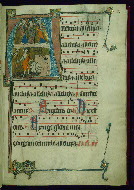
- Title: Initial "A" with Harrowing of Hell and three angel-musicians
- Form: Historiated initial "A," 4 lines of plainsong notation + 4 lines of text
- Text: Easter: vigils, opening cues to Vespers antiphon, psalm, responsory, hymn, versicle
fol. 3v:
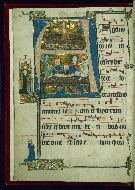
- Title: Initial "A" with the Resurrection and three Marys at the tomb
- Form: Historiated initial "A," 5 lines of plainsong notation + 5 lines of text
- Text: Easter Sunday, Matins, first responsory
fol. 10r:
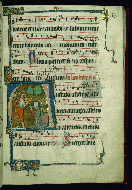
- Title: Initial "A" with "Noli me tangere"
- Form: Historiated initial "A," 3 lines of plainsong notation + 3 lines of text
- Text: Easter Sunday, Lauds, opening antiphon and responsory
fol. 13v:
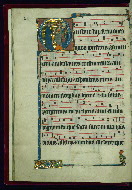
- Title: Initial "Q" with Road to Emmaus
- Form: Historiated initial "Q," 2 lines of plainsong notation + 2 lines of text
- Text: Easter week, feria ii (Monday), Benedictus antiphon
fol. 32v:
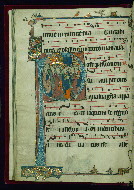
- Title: Initial "P" with Ascension
- Form: Historiated initial "P," 3 lines of plainsong notation + 3 lines of text
- Text: Ascension vigils, Matins, first responsory
fol. 44v:
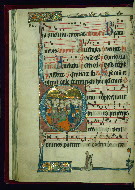
- Title: Initial "D" with Pentecost
- Form: Historiated initial "D," 3 lines of plainsong notation + 3 lines of text
- Text: Pentecost vigils, Matins, first responsory
fol. 60r:
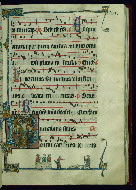
- Title: Initial "B" with Trinity in form of Crucifixion with Dove and inscribed scroll symbolizing God-Father
- Form: Historiated initial "B," 2 lines of plainsong notation + 2 lines of text
- Text: Trinity Sunday, Matins, first responsory
fol. 90r:
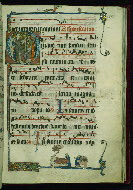
- Title: Initial "O" with Dedication of Church of Sainte-Marie of Beaupré
- Form: Historiated initial "O," 2 lines of plainsong notation + 2 lines of text
- Text: Dedication of Church vigils and office: Matins, first responsory
fol. 99r:
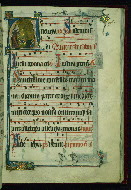
- Title: Initial "A" with St. Benedict's miraculous repair of sieve broken by his nurse
- Form: Historiated initial "A," 2 lines of plainsong notation + 2 lines of text
- Text: St. Benedict: cues to Vespers
fol. 99v:
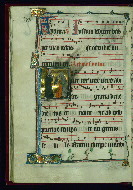
- Title: Initial "F" with St. Benedict's miraculous resuscitation of dead child
- Form: Historiated initial "F," 2 lines of plainsong notation + 2 lines of text
- Text: St. Benedict: Matins, first responsory
fol. 108r:
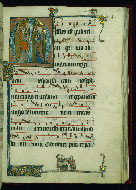
- Title: Initial "M" with Annunciation
- Form: Historiated initial "M," 3 lines of plainsong notation + 3 lines of text
- Text: Annunciation, Matins, first responsory
fol. 141v:
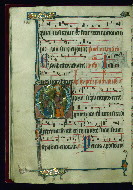
- Title: Initial "G" with St. Peter with Key, St. Paul with sword
- Form: Historiated initial "G," 2 lines of plainsong notation + 2 lines of text
- Text: SS. Peter and Paul, Commemoration of St. Paul: Vespers antiphon
fol. 143v:
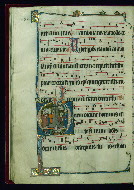
- Title: Initial "Q" with Crucifixion of St. Peter
- Form: Historiated initial "Q," 2 lines of plainsong notation + 2 lines of text
- Text: SS. Peter and Paul, Commemoration of St. Paul: Matins, first responsory
fol. 153r:
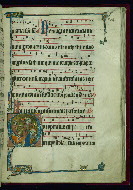
- Title: Initial "Q" with Martyrdom of St. Paul
- Form: Historiated initial "Q," 2 lines of plainsing notation +2 lines of text
- Text: Commemoration of St. Paul: Matins, first responsory
fol. 169r:
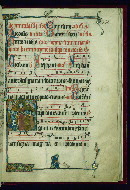
- Title: Initial "S" with St. Stephen revered by knight and kinswoman(?) in Cistercian habit
- Form: Historiated initial "S," 2 lines of plainsong notation + 2 lines of text
- Text: Invention of St. Stephen: Matins, first responsory
fol. 176v:
The binding is not original.
Late medieval binding possibly extant when acquired by John Ruskin, ca. 1850; rebound in England, after 1904; modern crimson velvet, worn; modern parchment pastedowns and endleaves; spine rounded and covered in red morocco; five compartments; gilt title "Antiphonarium Ecclesie S. Mariae de Bello Prato I MS. AD 1290"; edges are part gilt and partially painted blue; two rose silk ribbon fastenings, attached to upper and lower covers; red drop-front box, curved red morocco spine compartmentalized and titled the same as volume
Created in Hainaut ca. 1290 by the Cistercian monk Johannes de Toussens (see author portrait on fol. 1r of vol. III, W.761) for Béatrix of Grammont (1269-93/94), abbess, Cistercian abbey of Sainte-Marie of Beaupré at Grimmage near Geerardsbergen (Grammont, diocese of Cambrai, later Malines); Patroness, married into the de Viane family, depicted with a younger woman named Clementia
Abbess Jacquemine Hendricx, after 1476, Cistercian abbey of Sainte-Marie of Beaupré at Grimmage; extensive revisions, first of two major campaigns, begun under her
Abbess Angéline de Lossy (1755-96), eighteenth century; second campaign of extensive revisions; abbey seized during French Revolution and subsequently sold in 1797; church destroyed soon thereafter
John Ruskin, London, ca. 1850; likely his erasures of marginalia and grotesques
Arthur Severn (cousin of John Ruskin) and Mrs. Severn, London, ca. 1900-02/1904
Henry Yates Thompson, 1902, his bookplate; his sale, London, Sotheby's, June 22, 1921, lot 67, Pls. 4-6
Bernard Quaritch, London bookseller, after 1921
Sir A. Chester Beatty, his sale, London, Sotheby's, June 7, 1932
Spanish Art Gallery, London, after 1932
William Randolph Hearst, San Simeon, California, before 1951
Walters Art Museum, January 1957, gift of the Hearst Foundation
Cockerell, Sydney Carlisle. “LXXXIII. Antiphoner of the Cistercian Abbey of Beaupré, near Grammont.” In A Descriptive Catalogue of Twenty Illuminated Manuscripts Nos. LXXV to XCIV…in the Collection of Henry Yates Thompson. Cambridge: Cambridge University Press, 1907; pp. 55-74.
Van den Gheyn, J. "L'antipohnaire de l'abbaye de Beaupré près Grammont." Handelingen van de Oudheid- en Geschiedkundige Kring van Audenarde 2 (1908-1909): 195-200; pp. 195-200.
Thompson, Henry Yates. Illustrations of One Hundred Manuscripts in the Library of Henry Yates Thompson. Vol. 6. London, 1916; no. LXXXIII, Pls. XII-XXIII.
Cockerell, Sydney Carlisle, and Edward Fairbrother Strange. Catalogue of Miniatures, Leaves, and Cuttings from Illuminated Manuscripts. Exhibition Catalogue: Victoria and Albert Museum. London: H.M. Stationary Office, 1923; p. 11.
Millar, Eric G. The library of A. Chester Beatty: A Descriptive Catalogue of the Western Manuscripts. Vol. 2. Oxford: J. Johnson at the Oxford University Press, 1930; pp. 88-103, no. 63, Pls. CXXXIII-CXXXIX.
De Ricci, Seymour, and W. J. Wilson. Census of Medieval and Renaissance Manuscripts in the United States and Canada. Vol. 2. New York: H. W. Wilson Company, 1935; p. 1688, cat. no. 4.
Boeckler, Albert. Abendländische Miniaturen bis zum Ausgang der romanischen Zeit. Berlin: Walter de Gruyter and Co., 1938; pp. 51-52.
Loomis, Roger S., and Laura H. Loomis. Arthurian Legends in the Middle Ages. New York: Oxford University Press, 1938; p. 92.
Miner, Dorothy. "The Antiphonary of Beaupré." Journal of the Walters Art Gallery 9/8 (1957): 3-5; pp. 3-5, illus.
Faye, Christopher U., and William Henry Bond. Supplement to the Census of Medieval and Renaissance Manuscripts in the United States and Canada. New York: Bibliographical Society of America, 1962; p. 199, nos. 574, 577.
Miner, Dorothy. 2,000 Years of Calligraphy: A Three-Part Exhibition Organized by the Baltimore Museum of Art, the Peabody Institute, and the Walters Art Gallery. Baltimore: Trustees of the Walters Art Gallery, 1965; pp. 45-46 (fig. 27).
Dearden, J.S. "John Ruskin, the Collector: With a Catalogue of the Illuminated and Other Manuscripts Formerly in His Collection." The Library 21/2 (1966): 124-154; pp. 135, 136, 153.
Miner, Dorothy. "Since De Ricci- Western Illuminated Manuscripts Acquired since 1934: A Report in Two Parts. Part II." Journal of the Walters Art Gallery 31-32 (1968-1969): 40-117; pp. 62-68, figs. 15-17, 19.
Stones, M. Alison. "Illumination of the French Prose Lancelot in Flanders, Belgium, and Paris, 1250-1340." Ph.D. diss., University of London, 1970-1971; pp. 85, 111, 236-237, 244, 265 (n. 6).
Dearden, J.S. "Portrait of a Bibliophile XVI: John Ruskin, 1819-1900." The Book Collector 21 (1972): 203-213; p. 203.
Dearden, J.S. "Bulletin codicologique." Scriptorium 27 (1973); pp. 123 (cat. no. 79), 395 (cat. no. 764).
Du Bouveret, Bénédictins. Colophons de manuscrits occidentaux des origines au XVIe siècle. Spicilegii Friburgensis Subsidia 4. Vol 3. Fribourg: Editions Universitaires Fribourg Suisse, 1973; p. 123, cat. no. 8406.
Phillips, Ira. "Illustrations." In Encyclopedia of Library and Information Science: Volume 11. Edited by Allen Kent, Harold Lancour, and Jay E. Daily, 219-263. New York: Marcel Decker, Inc, 1974; p. 234.
Alexander, Jonathan J. G. The Decorated Letter. New York: George Braziller, 1978; pp. 104-105 (Pl. 33).
Glorieux, Therese. "Provenances monastiques des manuscrits medievaux des anciens pays -bas meridionaux de la iv serie a la bibliotheque royale albert ier a bruxelles." Miscellanea codicologica F. Masai Dictata. Vol. 2. Edited by Peter Cockshaw (Les Publications de Scriptorium, 8, 1979) 559-575; cat. nos. 19, 39.
"Abbaye de Beaupré à Grimminge." Monasticon Belge 7, Province de flandre orientale. Vol. 3. Liège: Abbaye de Maredsous, 1980; pp. 309-310, 314.
Hauck, Alice H.R. "John Ruskin's Uses of Illuminated Manuscripts: The Case of the Beaupré Antiphonary." Arts Magazine 56 (1981): 79-83; pp. 79-83.
Plotzek, Joachim M. Die Handschriften der Sammlung Ludwig. Vol. 2. Cologne: Schniitgen-Museum der Stadt Köln, 1982; pp. 70, 80.
Büttner, F.O. Imitatio Pietatis: Motive der christlichen Ikonographie als Modelle zur Verähnilichung. Berlin: Gebrüder Mann Verlag, 1983; pp. 135, 206.
Calkins, Robert G. Illuminated Books of the Middle Ages. Ithaca: Cornell University Press, 1983; pp. 234-242, 248, Pls. 20, 129-130.
Hauck, Alice H.R. "John Ruskin's Use of Illuminated Manuscripts and Their Impact on His Theories of Art and Society." Ph.D. Diss., Johns Hopkins University, 1983; pp. 60-61, 72-73, 76-77.
Thomson, James. C. Music Through the Renaissance. Dubuque: W.C. Brown Publications, 1984; pp. 54, 55, 60, fig. 3.3.
Gaspar, Camille, and Frédéric Lyna. Les principaux manuscrits à peintures de la Bibliothèque royale de Belgique. Brussels: Bibliothèque royale de Belgique, 1987; p. 199.
Randall, Lilian M.C. "From Cîteaux Onwards: Cistercian-Related Manuscripts in the Walters Art Gallery. In Studies in Cistercian Art and Architecture. Vol. 3. Edited by Meredith P. Lilich, 111-136. Kalamazzo, Michigan: Cistercian Publications, 1989; p. 113.
Stones, M. Alison. "Madame Marie's Picture-Book: A Precursor of Flemish Painting around 1400." In Flanders in a European Perspective: Manuscript Illumination around 1400 in Flanders and Abroad. Proceedings of the International Colloquium, Louvain. Edited by Maurits Smeyers and Bert Cardon, 429-443. Leuven: Peeters, 1995; pp. 429-443.
Oliver, Judith. "Worship of the Word: Some Gothic Nonnebücher in Their Devotional Context." In Women and the Book: Assessing the Visual Evidence. Edited by Lesley Janette Smith, and Jane H. M. Taylor, 106-121. Toronto and Buffalo: University of Toronto Press, 1997; p. 119.
Randall, Lilian M. C. Medieval and Renaissance Manuscripts in the Walters Art Gallery. Vol. 3, Belgium, 1250-1530. Baltimore and London: Johns Hopkins University Press in association with the Walters Art Gallery, 1997; pp. 26-56, cat. no. 219.
France, James. The Cistercians in Medieval Art. Cistercian Studies 170. Collegeville, MN: Cistercian Publications, 1999; p. 260.
Smeyers, Mauritis. Flemish Miniatures from the 8th to the Mid-16th Century: The Medieval World on Parchment. Turnhout, Belgium: Brepols, 1999; pp. 148, 149, 177.
Higgitt, John. The Murthly Hours: Devotion, Literacy and Luxury in Paris, England and the Gaelic West. London: The British Library, 2000; pp. 55, 99.
Plummer, Robin. Illuminated Manuscripts. Leicester: Brockhampton Press, 2000; p. 54.
Bennett, Adelaide. "Continuity and Change in the Religious Book Culture of the Lowlands in the Thirteenth and Fourteenth Centuries." In Medieval Mastery: Book Illumination from Charlemagne to Charles the Bold (800-1475). Edited by William Noel and Lee Preedy, 166-179. Turnhout, Belgium: Brepols, 2002; p. 178.
Noel, William. "45a Beaupré Antiphonary." In Medieval Mastery: Book Illumination from Charlemagne to Charles the Bold (800-1475). Edited by William Noel and Lee Preedy, 216-217. Turnhout, Belgium: Brepols, 2002; pp. 216-217.
De Hamel, Christopher. "Books in the Church." In Medieval Mastery: Book Illumination from Charlemagne to Charles the Bold (800-1475). Edited by William Noel and Lee Preedy, 46-55. Turnhout, Belgium: Brepols, 2002; pp. 50 (fig. 4), 51.
Gummlich, Johanna Christine. Bildproduktion und Kontemplation.: Ein Überblick über die Kölner Buchmalerei in der Gotik unter besonderer Berücksichtigung der Kreuzigungsdarstellung. Weimar: Verlag und Datenbank fur Geisteswissenschaften, 2003; p. 128, 132.
Gathercole, Patricia M. The Depiction of Angels & Devils in Medieval French Manuscript Illumination, Vol. 32. Lewiston, NY: Edwin Mellen Press, 2004; p. 11.
Greenia, George D. "The Bigger the Book: On Oversize Medieval Manuscripts." Belgisch tijdschrift voor philologie en geschiedenis 83/3 (2005): 723-745; p. 743.
Dekeyzer, Brigitte. "For Eternal Glory and Remembrance: On the Representation of Patrons in Late Medieval Panel Paintings in the Southern Low Countries." In The Use and Abuse of Sacred Places in Late Medieval Towns. Edited by Paul Trio and Marjan de Smet, 71-102. Leuven: Leuven University Press, 2006; p. 85.
Hunt, Elizabeth Moore. Illuminating the Border of French and Flemish Manuscripts, 1270–1310. London: Routledge, 2006; p. 180 (n. 26).
Hoffmann, Richard C. "Economic Development and Aquatic Ecosystems in Medieval Europe." In Internal Colonization in Medieval Europe, Part 2. Edited by Felipe Fernández-Armesto and James Muldoon, 633-672. Surrey: Ashgate/Variorum, 2008; p. 655.
Principal cataloger: Randall, Lilian M.C.
Cataloger: Herbold, Rebekah
Editor: Herbert, Lynley
Copy editor: Dibble, Charles
Conservators: Owen, Linda; Quandt, Abigail
Contributors: Emery, Doug; Herbert, Lynley; Herbold, Rebekah; Noel, William; Schuele, Allyson; Tabritha, Ariel; Toth, Michael B.; Wiegand, Kimber
The Walters Art Museum
Licensed for use under Creative Commons Attribution-ShareAlike 3.0 Unported Access Rights, http://creativecommons.org/licenses/by-sa/3.0/legalcode. It is requested that copies of any published articles based on the information in this data set be sent to the curator of manuscripts, The Walters Art Museum, 600 North Charles Street, Baltimore MD 21201.
